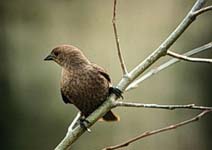Spatial distribution, movement tactics, and demography of an invasive predator/ brood parasite
 |
The shift in the structure of large-mammal communities with increasing human footprint was concordant with similar changes in terrestrial landbirds. Large-scale surveys led by Dr. Erin Bayne during Phase I of the Chair found dramatic changes in the frequency of generalist birds near linear features, wellpads and compressor stations relative to native boreal specialists. While many of these associations were predictable based on habitat requirements of the generalist species, the increased abundance of the non-native cowbird in landscapes with higher human footprint raises concerns. As a nest predator and obligate-brood parasite, the brown-headed cowbird can have significant impacts on the population dynamics of its passerine hosts. Conventional wisdom suggests invasion of cowbirds is mainly the result of expanding cattle grazing in forested systems. If true, then population growth of invasive cowbirds in the boreal forest may be limited by constraints imposed by their foraging/ parasitism behaviour. Cowbirds are assumed to make daily “commuting trips” between foraging areas near cattle pastures and forests where they parasitize hosts. Commuting distance could place an upper limit on the area of forest that individual cowbirds can exploit. If cowbirds are obligate commuters, then the spatial distribution of cattle, the area used by individual cowbirds, and maximum commuting distance should be sufficient to estimate maximum population size and zone of impact of cowbirds.
A key uncertainty however is whether or not all cowbirds are obligate commuters. In addition to the increased abundance of cowbirds we observed, our data suggest cowbirds are occurring farther from grazing areas than their predicted maximum commuting distance would allow. These observations suggest a degree of behavioral flexibility and imply some cowbirds may have adopted a “forest-resident” tactic. However, such associations could also reflect cowbird use of these habitats as a means of facilitating longer commuting distances. To test whether cowbirds are actually obligate commuters or are using a forest-resident strategy, a PhD? student will fit female cowbirds with radio transmitters at varying distances from grazing areas. If cowbirds are obligate commuters, we predict that regardless of whether female cowbirds are captured at pasture edge or in the forest interior they will regularly move into and out of the forest. These data will also allow us to test the landscape facilitation hypothesis. If seismic lines, roads, or well pads facilitate movement of cowbirds in forested landscapes rather than acting as foraging areas, cowbirds should preferentially select these habitats when commuting but return to pastures daily. The success of “forest-resident” vs. “pasture-dependent” cowbirds will be tested by examining the number of post-ovulatory follicles to determine rates of egg production in these groups. Combined with longer-term banding efforts on cowbirds these data will allow us to assess whether local populations of cowbirds in forested systems are increasing within the forested matrix itself or whether the increases we see are driven by regional effects of agriculture.